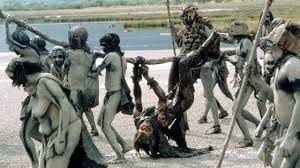SHORT TAKE:
Charming and interesting but missing significant parts of the story. Recommended for only those well versed in the complete Biblical account.
LONG STORY:
I do not mind creative retelling of Biblical stories as long as they are faithful (literally) to the source material, in spirit, if not in fact. Liturgical dramas have been documented all the way back to the 10th century. Many were performed in the church, although not part of the liturgy. And some wonderfully portrayed Biblical stories emerge from the most unlikely of places. In the 1990’s, Ted Turner, who at the time was openly and aggressively agnostic, and who referred to Christians as “losers”, produced some truly magnificent, accurate and respectful TV movies portraying the Patriarchs, featuring a cavalcade of (at the time) “A” listers: Richard Harris and Barbara Hershey as Abraham and Sarah, Ben Kingsley doing double duty as Moses and Potiphar, Leonard Nimoy as Samuel and Jonathan Price as Saul, to name only a few. These Turner productions took a few liberties, which did nothing to disrespect or undermine the historicity or religious narrative. The point being that there is a millenia-long, distinguished tradition of respectful, imaginative, interpretations of Biblical events.
So, I had high hopes for a musical version of the Nativity story in Journey to Bethlehem, especially having seen the talented Antonio Banderas in the trailers belting it out as King Herod.
There is much to recommend the movie, which is quite charming. The songs are catchy and lyrically emote the internal turmoil of the characters, as all good musical songs should. The performers had strong and energetic voices, the comic reliefs were cute, and the actors playing Mary and Joseph (Fiona Palomo and Milo Manheim) sparked chemistry, convincingly portraying innocence without being saccharin.
There were even some inspired creative aspects. Antonio Banderas’s gleefully evil King Herod gives Shatner’s Kirk a run for his money in scene chewing. Herod’s conflicted first born was an interesting plot twist. And something that might be misinterpreted as inaccurate was appealingly depicted. The Archangel Gabriel paces nervously as he is about to greet Mary, practicing different ways he might introduce his mission to her. This is actually not as far out as one might think. In his Biblical greeting Gabriel says “Hail Mary FULL of Grace!” This has been interpreted by religious scholars to mean that Gabriel was, indeed, marveled by Mary, the human of perfect soul and the first person since Adam and Eve to be born without sin. So for Gabriel to be shown as just a bit nervous was not out of line and was kind of adorable.
There were aspects that did not fit the time period. The choreography, for example, was more Ballywood than Biblical, and the “romance” between Mary and Joseph reminded me more of La La Land than Luke’s Book. But anachronisms do not necessarily diminish the legitimacy of the presentation. Much Renaissance religious art showed Biblical figures in European garb, such as: the Donne Triptych, Madonna of the Meadow by Raphael and The Virgin Mary by Van Eyck. Even the controversially born Jesus Christ Superstar was endorsed by the Vatican on December 13, 1999, during the papacy of Saint Pope John Paul II, despite its anachronistic trappings.
I did think the writers pushed it to the edge of the envelope in the contrived dialogues between Mary and her parents, wherein Mary expressed her dismay both in being betrothed to a man she had never met (which was pretty much de rigeur then and would not have been a surprise) and that she would have preferred to become a teacher rather than “forced” into the more mundane obligations of wife and mother. This chronologically challenged, modernistic, angsty teenage attitude is simply out of character for Mary, who was without sin and would not have been confrontational with her obviously caring and attentive father. But as she ultimately agreed, I chalked it up to the writers showing how she was obedient despite her trepidations.
And, Joseph’s moaning about how his dream to be an “inventor” would somehow be thwarted by his nuptials was a bit ridiculous. Joseph was a carpenter and his modern age kvetching about unfulfilled daydreams was a bit silly.
Now, (SPOILER) I really do have an issue with a kiss between Mary and Joseph at the end of the movie, which implied there would be more than a chaste relationship between them in the future. While this kiss and its “promise” keeps to the rom com formula of the disparate couple finally falling in love, it is COMPLETELY inappropriate for the relationship between Joseph and Mary. Mary was God’s spouse, the Mother of His Son and Joseph was Jesus’ foster father and Mary’s protector, nothing else, (quite enough for one lifetime).
However, what troubled me most was not what was IN the movie but several things that had been left out. When Gabriel announces to Mary that God had chosen her to be the Mother of His Son, the writers left out Mary’s consent! Her last word as Gabriel departs is: “But I have so many questions.” That is a serious breach of Biblical narrative and context. Theologically, neglecting, “I am the handmaid of the Lord. May it be done to me according to Your Word,” is not a minor quibble. Leaving out Mary’s express and freely given consent is not only inaccurate but a dangerous misunderstanding of Scripture. This guts the infinitely important point of contrast between Mary’s obedience and Eve’s disobedience. It’s not as though these lines are under copyright protection AND, these expressions of faith are in most Protestant as well as Catholic Bibles, so I do not understand why the writers failed to include them here.
Similarly, when Mary reaches her Cousin Elizabeth they embrace silently. No where are the lines: “Blessed are you among women and blessed is the fruit of thy womb, Jesus,” wherein Elizabeth acknowledges Mary’s position as Queen Mother of the Lord, and mentions John (the future Baptizer) leaping within her – a clear affirmation of the unborn disciple’s recognition of Our Lord and Savior even in the womb. Also neglected was Mary’s Magnificat: “My soul doth magnify the Lord, and my spirit hath rejoiced in God my Savior,” additional acknowledgement of her understanding of her place in what Bishop Robert Barron consistently refers to as Mary’s place in God’s Theo-drama, to which Mary FREELY CONSENTED.
Sadly, these significant blemishes could have been so easily repaired by the insertion of just a few sentences lifted out of the Bible. The 2017 animated feature, The Star, FROM AFFIRM, THE SAME PRODUCTION COMPANY, which shows the Nativity mostly through the eyes of a sentient donkey, clearly included Mary’s express consent: “Yes. Let it be done just as you say.”
Over all I’d give Journey to Bethlehem a qualified approval. But, I regret it is not for the demographic for which I think the producers were aiming. This is an awful shame, as with but a couple of small additions it could have been SO much better and spiritually fulfilling for all audiences. Those of immature or incomplete religious teaching may find some of the issues I have mentioned, and for the reasons I have given, confusing and damaging to their spiritual formation. But for those who are well informed and reasonably mature, who can afford to turn their brain off a bit and overlook the deficiencies in the script, Journey to Bethlehem can prove a relaxing, if fluffy, dose of Advent entertainment.
For the more impressionable or less well-formed, despite the animated silliness, I would rather recommend The Star.








































 Both the audience and he realize along the way, that if he survives his adventure, he will become the capable man and leader he otherwise would not have been.
Both the audience and he realize along the way, that if he survives his adventure, he will become the capable man and leader he otherwise would not have been.









